By Harriet Goodwin
How we interact and connect with where we live is essential to achieving a sense of place. It’s a process that nurtures identity and reveals our collective values.
Learning about a place’s history can bring this connection even further, giving context to the time you call home. In order to get that scope of things, it takes considering the significant people, events and industries that have all contributed to the present moment in our sense of place. Public art pieces are a great way to explore the various layers of local history, discovering what creatives had to say about the past, what it says about when it was created, and how it may shape our future.
Vancouver
Four Boats Stranded: Red and Yellow, Black and White
By Ken Lum
By Transit: From Vancouver City Centre station, it’s a 3-minute walk east!

This public installation is a good reminder to look up from the downtown hustle and bustle now and then.
Installed in 2001, four fibreglass boats sit on top of the Vancouver Art Gallery as part of a public art project called On Location: Public Art for the New Millennium. Artist Ken Lum is well-known for his conceptual work that explores a sense of place (think of the East Van cross!), so much so that he might appear again later in this article!
Each mounted boat represents one from Vancouver’s history, while their colours indicate the colonial stereotyping of cultural/racial identification. The piece shows how art can be used as a tool to tell the darker parts of a city’s history.
The red boat is a First Nations Longboat, while a replica of Captain George Vancouver’s ship is represented in white. The black vessel represents the Komagata Maru, an immigrant ship that arrived in Coal Harbour in 1914 after seven weeks at sea. Government officials later forced the 376 passengers aboard to return to India after refusing the claim that they were citizens of the British Empire. The incident, thankfully, was a catalyst for a change to immigration laws.
Representing more recent history, the yellow boat represents a ship that carried around 200 migrants from China’s Fujian Province who claimed refugee status on Vancouver Island the year before the project was installed.
750 Hornby St, Vancouver
Whistler
Memorial Sculpture for Seppo Jalmari Makinen
By Christina Nick
By Transit: There are several shuttles you can take to Whistler from Vancouver! You can visit the Tourism Whistler page here to find a reliable option from where you’re located.
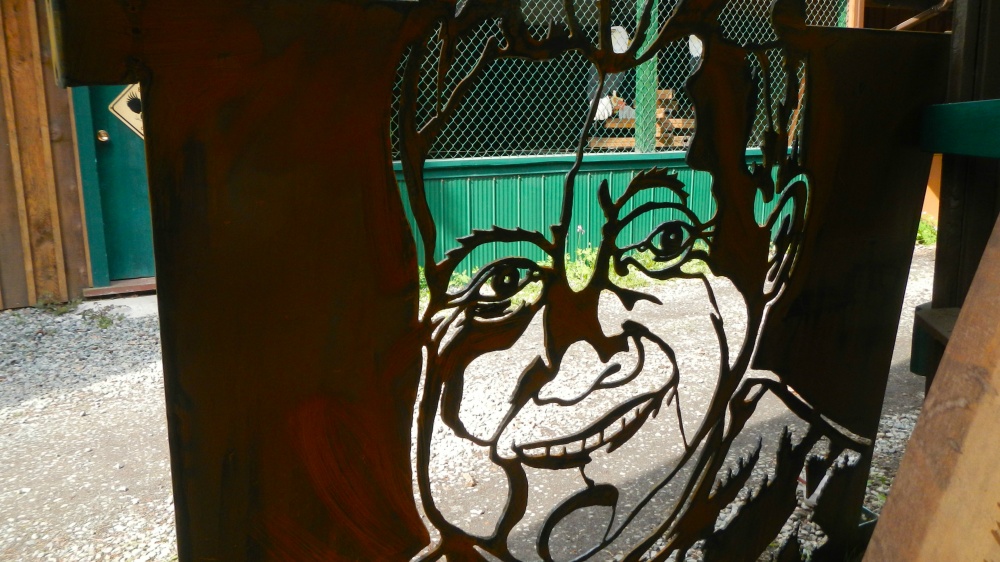
The Whistler Museum and Archives Society commissioned this wood and steel cut-out sculpture to celebrate the legacy of local icon, Seppo Makinen. Makinen was instrumental in shaping Whistler as it’s experienced by visitors and residents today.
Born in 1928 Finland, he first immigrated to Eastern Canada, eventually making his way to Whistler via an opportunity with Garibaldi Lifts Limited, which was formed to develop a ski resort in the area.
Makinen worked for decades with his crews to clear the original ski runs on Whistler Mountain, and the logs that frame the steel panel represent his career as a logger.
He was a character who was known for his big personality and legendary parties. Much loved by the Whistler community, his legacy was further secured when a black diamond ski run was named after him!
It just shows the power of public art to commemorate people who have shaped more recent history.
Entrance to Lost Lake, Whistler
Langley
Flying Seven
By Randi Hamel, Taj Jamal, Kelly Mellings, and Allan Whincup of Pulp Studios
By Transit: From Surrey Central Station, take the #503 Fraser Hwy Exp/Aldergrove bus to 216 St and 5300 Block

Langley has always had a strong connection to aviation, and with this recent airport mural, seven local pioneers of the field are given a fitting tribute.
Commemorating BC’s first female pilots, this group flew as part of the war effort, dropping pamphlets from their aircraft to aid the cause. This was all despite having been denied entry to the military based on their gender. The mural celebrates the women breaking down boundaries while showing courage and resilience.
Created by artists from Pulp Studios, the group won a call for submission for the project, and the Township of Langley supported the process through the Arts and Culture Division.
Langley Airport – 5385 216 St #305, Langley Township
(north end of the airport building when driving south on 216 Street)
Surrey
The Sea Captain
by Marianne Nicolson with John Livingston
By Transit: Take the Expo Line Skytrain all the way to the end of the line (almost) and the second to last stop: Surrey Central Station
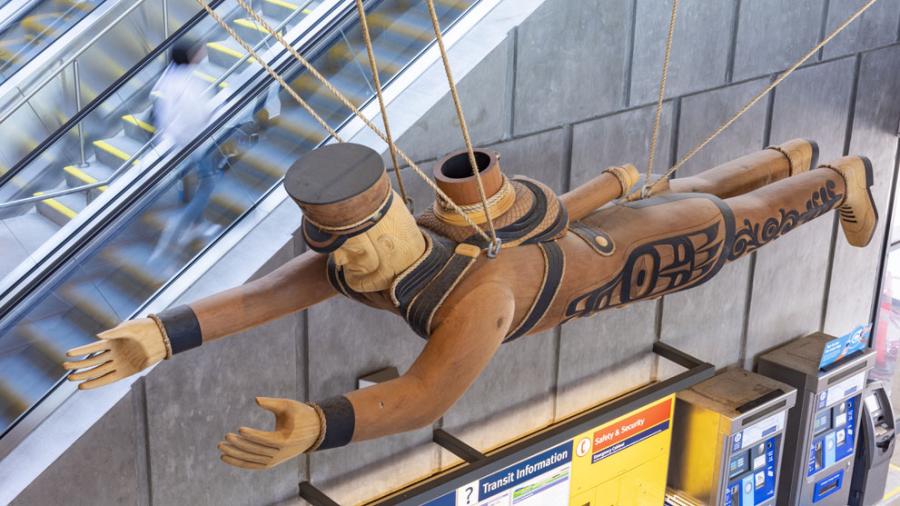
Inspired by the design of a 19th-century smoking pipe from Haida Gwaii, this piece hangs in one of BC’s busiest transit hubs, Surrey Central Station. The wooden sculpture represents the area’s colonial history as it was common for Pacific Northwest Coast First Nations to depict the arriving settlers that came on trading ships in art. A practice that eventually became a part of Kwakwaka’wakw imagery and ceremony.
The two artists, Marianne Nicolson (‘Tayagila’ogwa) and John Livingston, used the original pipe’s design for the piece, and you can see on the captain’s backpack where the bowl of the pipe would have been. With his arms stretched out, the captain poses in a gesture of giving or receiving.
“This symbolism reminds us that the creation of a homeland on these coasts relies heavily on the peaceful and honourable negotiations between arriving and existing peoples, as well as with the land itself,” Nicolson says of the installation.
It’s a striking piece in scale and is an impressive testament to the passage of customs between generations. Nicolson’s partner on the project, Livingston, was a master carver and sadly passed away the year it was installed, giving the piece further generational significance.
Surrey Central SkyTrain Station, 10309-10321 City Parkway, Surrey
Vancouver’s North Shore
Blanketing the City V
By Debra Sparrow (xʷməθkʷəy̓əm), Buddy Joseph, Chief Janice George (Skwxwú7mesh) and Angela George (səlilwətaɬ)
By Transit: From the Lonsdale Quay Seabus terminal, walk east along the water towards the Shipyards, you can’t miss it!
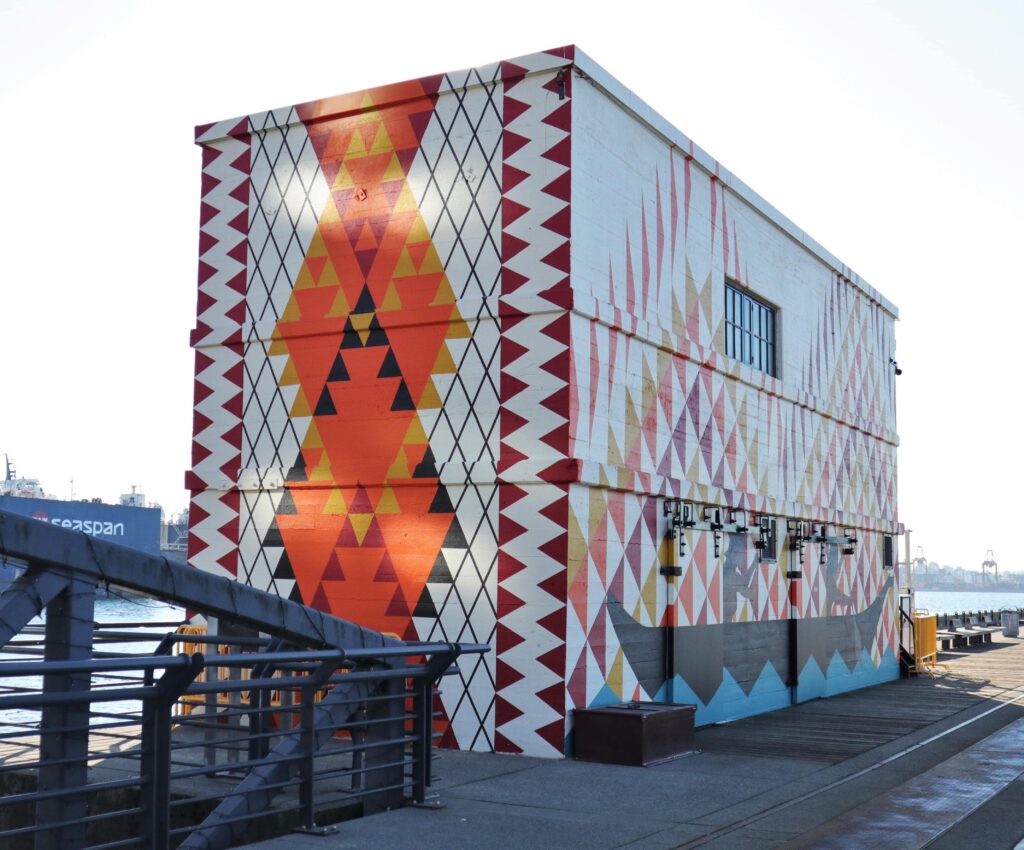
This is the fifth piece in a series of six that brings together weaving artists from three local nations. Covering an entire building on the Burrard Pier, this project tells the story of the 1886 Great Vancouver Fire that burned for 45 minutes and left only eight buildings standing. While a tragedy, the event’s legacy also includes a story of heroism with the role Indigenous first responders from the village of Eslha7an played in bringing people to safety across the Burrard Inlet.
As one of the artists, Angela George, says, “When my ancestors saw the flames, they got into their canoes and paddled over to help. The people in the city were all standing in the water in the inlet seeking shelter from the heat. My great-grandmother witnessed the fire and passed down to me the story of a woman singing the Paddle Song while she was rescuing people on the beaches in her canoe. The Paddle Song is used today for different occasions. It is about people being on their journeys and is sometimes used for funerals. My Squamish ancestors, longshoreman, loggers and carpenters helped rebuild the city after the fire.”
On the side by artist Debra Sparrow, the piece shows the fire’s aftermath with glowing embers represented in a Coast Salish design aesthetic. “It is important to appreciate the irony of (it),” reflects Sparrow. “Indigenous people paddling across the inlet to risk their lives to rescue the people from a town that was systematically evicting Musqueam, Squamish and Tsleil-Waututh people from their lands. This says a lot about who we are.’
The fire in Sparrow’s design also symbolizes the destruction caused by colonization and the residential school system. while the land and water represent restorative ancient wisdom – a reminder that as long as we live in harmony with the land, it will continue to sustain, heal and nourish all living things.
For more pieces of public art across the North Shore, visit this free online culture map
The Shipyards, Victory Ship Way, North Vancouver
New Westminster
Columbia Street Mosaics
By Bruce Walther and Liz Calvin
By Transit: From the Columbia Skytrain station, you can easily walk up the street looking at each mosaic!
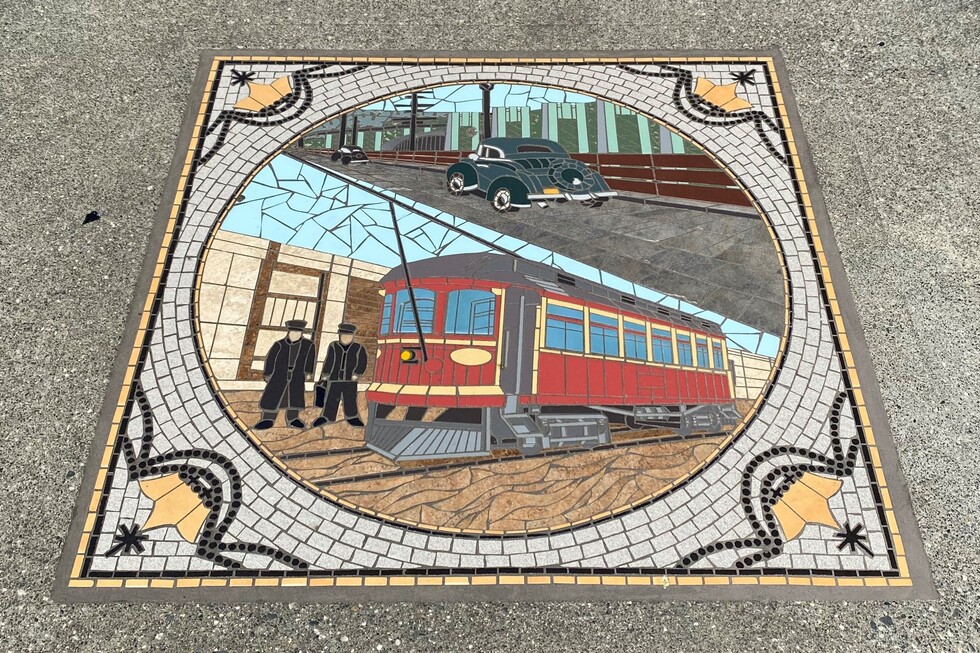
Along Columbia Street in downtown New West, this series of eight mosaics was created as part of a community art project to tell the story of how the city began. Mosaic Artist Bruce Walther, who lives and works in Vancouver’s Downtown East Side, completed this project with Liz Calvin, a BC-based artist who studied mosaics in Italy.
Each piece spans different themes that thread through the history of New Westminster. Among them, Chinese settlement (there have been three Chinatowns throughout the city’s history!), the entertainment district, the Golden Mile (the nickname of the area due to the post-WWII economic boom), the working waterfront (the Fraser River has always been an important location for Indigenous communities and a major contributor to local industry), and transportation (including the BC Electric Railway era depicted above).
To learn more in-depth versions of each story, you can take one of the self-guided tours the city has put together for visitors.
Burnaby
The Retired Draught Horse and the Last Pulled Log
By Ken Lum
By Transit: From Edmonds Skytrain station, you can take the #106 New West Station bus to Edmonds St and Kingsway
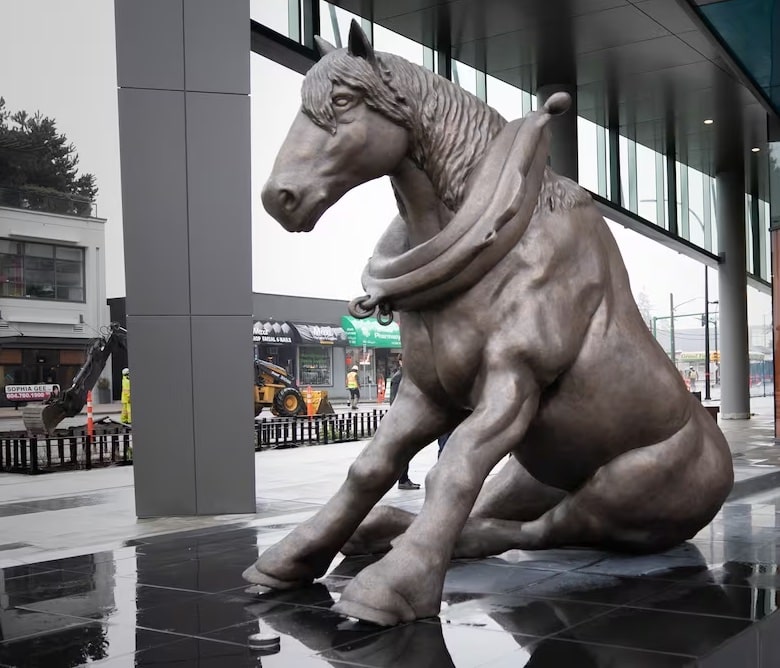
Ken Lum’s bronze sculpture shows a draught horse sitting on his hind legs in a pose symbolizing that it’s retired from work.
In Burnaby’s early days, draught horses were used to carry logs and other agricultural resources up and down transport routes from the farms into the city. This piece marks the spot of one of such routes. Nearby is a log with a chain – presumably broken off from the horse, as he rests observing the surrounding urban development.

To easily plan the route for your next artistic outing, you can use the TransLink Trip Planner.
The post Exploring the Past Through Public Art appeared first on West Coast Curated.
